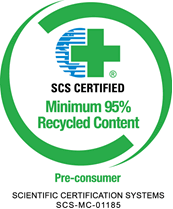USG has been using mined gypsum for more than 100 years and synthetic gypsum for more than 30 years in making building construction products. The value of synthetic gypsum and the difference between it and fly ash have been the topic of much discussion around the composition of gypsum roof boards. The two are both products of burning coal: synthetic gypsum is made through a process of flue gas desulfurization or “scrubbing” coal plant emissions to remove the sulfur dioxide, while fly ash is a waste product from the burning of coal. Today, a lot of gypsum products use synthetic gypsum in their manufacturing process including Securock® Gypsum-Fiber roof boards. We would like to discuss the benefits of synthetic gypsum as well as how it is different from flyash.
Synthetic Gypsum Is Environmentally Friendly
Products that use synthetic gypsum in their manufacturing processes contribute to a cleaner environment in at least two ways by making power plant emissions cleaner and keeping material out of landfills.
 First of all, the principal source of synthetic gypsum is from removing polluting gasses from power plants to reduce emissions of harmful materials into the atmosphere. In the process of flue-gas desulfurization (discussed later), synthetic gypsum is produced which is identical to natural gypsum.
First of all, the principal source of synthetic gypsum is from removing polluting gasses from power plants to reduce emissions of harmful materials into the atmosphere. In the process of flue-gas desulfurization (discussed later), synthetic gypsum is produced which is identical to natural gypsum.
Finally, the synthetic gypsum that is produced would need to be landfilled if another option wasn’t found. Luckily, because it is the exact chemical match of natural gypsum (CaSO4 ·2H20), it can be used as a direct substitute. So, manufacturers don’t need to use the resources to mine gypsum and they can use a material that was going to be lost in a landfill – a win on both sides of the sustainability scale. Synthetic gypsum is one of the ways that Securock Gypsum-Fiber becomes 95% recycled content.
In conclusion, synthetic gypsum provides a powerful environmental solution by taking harmful emissions out of the atmosphere and using a valuable resource rather than wasting away in a landfill.
How Synthetic Gypsum Is Made
Synthetic Gypsum is a by-product of the flue gas desulfurization (FGD) process, commonly known as “scrubbing.” Flue gas desulfurization is a chemical process to remove sulfur oxides from the flue gas at coal-burning powerplants. Their goal is to chemically combine the sulfur gases released in coal combustion by reacting them with a sorbent, such as limestone (calcium carbonate, CaCO3). As the flue gas comes in contact with the slurry of calcium salts, sulfur dioxide (SO2) reacts with the calcium to form hydrous calcium sulfate (CaSO42H2O) or commonly known as synthetic gypsum.

Flow diagram of the flue-gas-desulfurization process based on lime (CaO) or limestone (CaCO3), which are the sorbents used by 90 percent of FGD systems in the United States.
Synthetic Gypsum Driven By Safety
Several groups have developed specifications and guidelines covering the chemical and physical aspects of synthetic gypsum to insure that the material will be safe for manufacturing use. There are differences in synthetic gypsum and the better the quality of the material the more valuable it is.
USG conducts rigorous testing on both the synthetic gypsum and mined gypsum we use to ensure that the gypsum meets our established quality, purity, and production standards. USG also requires the synthetic gypsum supplier (the power plant) to conduct quality control testing of the shipments of synthetic gypsum to our plants. In addition, USG conducts quality  control and assurance testing at our manufacturing facilities and tests both the synthetic gypsum and the mined gypsum we use for purity and the presence of contaminants. These tests are conducted by our own research scientists as well as certified third party laboratories. And because USG’s number one core value is safety, you can be assured that we only use a safe product for our employees and customers. The gypsum that USG uses to make its products is safe and meets our quality, purity, and production standards.
control and assurance testing at our manufacturing facilities and tests both the synthetic gypsum and the mined gypsum we use for purity and the presence of contaminants. These tests are conducted by our own research scientists as well as certified third party laboratories. And because USG’s number one core value is safety, you can be assured that we only use a safe product for our employees and customers. The gypsum that USG uses to make its products is safe and meets our quality, purity, and production standards.
Finally, as stated by the U.S. Environmental Protection Agency, FGD gypsum is not a waste product from coal combustion but, rather, is a specially-created product that “serves exactly the same function” as mined gypsum in wallboard.
Synthetic Gypsum Is Not Flyash
There’s a lot going on in the world and it’s easy for us to get confused about things that aren’t in our minds day to day. One thing that occasional gets misunderstood in the market is how synthetic gypsum relates to flaysh. Synthetic gypsum and fly ash are completely different substances. Fly ash is not used as a substitute for gypsum because fly ash has a different chemical composition from gypsum. Synthetic gypsum (CaSO42H2O) is produced from FGD and is the chemical equivalent of natural gypsum. Flyash is a residue generated from combustion and is captured by some type of filtration equipment and is used in various ways but never as a substitute for gypsum. There are several resources that talk more about flyash.
Conclusion
For more than 100 years, safety and quality have been USG’s core values. We are confident that our products are safe and of the highest quality. Synthetic gypsum is a material that significantly adds to the positive impact of our environment while being greatly useful as a substitution for natural gypsum.

Leave a Comment